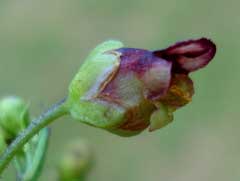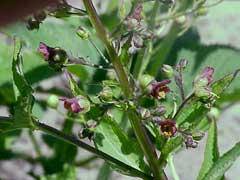 |
|
http://commons.wikimedia.org/wiki/User:Fornax |
 |
| biolib.de |
Translate this page:
Summary
Physical Characteristics

 Scrophularia umbrosa is a PERENNIAL growing to 1.5 m (5ft) at a fast rate.
Scrophularia umbrosa is a PERENNIAL growing to 1.5 m (5ft) at a fast rate.
See above for USDA hardiness. It is hardy to UK zone 7. It is in flower from June to September, and the seeds ripen from July to September. The species is hermaphrodite (has both male and female organs) and is pollinated by Bees, wasps.
It is noted for attracting wildlife.
Suitable for: light (sandy), medium (loamy) and heavy (clay) soils. Suitable pH: mildly acid, neutral and basic (mildly alkaline) soils. It can grow in semi-shade (light woodland) or no shade. It prefers moist or wet soil.
UK Hardiness Map
US Hardiness Map
Synonyms
S. alata. S. aquatica. L. (name ambiguous). S. neesii.
Plant Habitats
Woodland Garden Dappled Shade; Shady Edge; Bog Garden;
Edible Uses
Edible Parts: Root
Edible Uses:
Root - cooked[2, 105]. There must be some doubts about the edibility of this root[K].
References More on Edible Uses
Medicinal Uses
Plants For A Future can not take any responsibility for any adverse effects from the use of plants. Always seek advice from a professional before using a plant medicinally.
Detergent Eczema Vulnerary
The leaves are detergent and vulnerary[4]. They are harvested as the plant comes into flower and can be used fresh or dried for later use[4]. The plant has a good reputation as a wound herb, either applied externally as a poultice or taken as a decoction[4]. Water betony is said to have similar medicinal properties to the knotted figwort, S. nodosa[254]. These properties are as follows:- Knotted figwort is a plant that supports detoxification of the body and it may be used as a treatment for various kinds of skin disorders[254]. The whole plant is alterative, anodyne, anti-inflammatory, diuretic, mildly purgative and stimulant[4, 9, 21, 165]. It is harvested as the plant comes into flower in the summer and can be dried for later use[4]. A decoction is applied externally to sprains, swellings, burns, inflammations etc, and is said to be useful in treating chronic skin diseases, scrofulous sores and gangrene[4, 254]. The leaves can also be applied fresh or be made into an ointment[4]. Internally, the plant is used in the treatment of chronic skin diseases (such as eczema, psoriasis and pruritis), mastitis, swollen lymph nodes and poor circulation[238]. It should not be prescribed for patients with heart conditions[238]. The root is anthelmintic[9].
References More on Medicinal Uses
The Bookshop: Edible Plant Books
Our Latest books on Perennial Plants For Food Forests and Permaculture Gardens in paperback or digital formats.

Edible Tropical Plants
Food Forest Plants for Hotter Conditions: 250+ Plants For Tropical Food Forests & Permaculture Gardens.
More

Edible Temperate Plants
Plants for Your Food Forest: 500 Plants for Temperate Food Forests & Permaculture Gardens.
More

More Books
PFAF have eight books available in paperback and digital formats. Browse the shop for more information.
Shop Now
Other Uses
References More on Other Uses
Cultivation details
Succeeds in most moist soils. A good bee plant[4].
References Carbon Farming Information and Carbon Sequestration Information
Temperature Converter
Type a value in the Celsius field to convert the value to Fahrenheit:
Fahrenheit:
The PFAF Bookshop
Plants For A Future have a number of books available in paperback and digital form. Book titles include Edible Plants, Edible Perennials, Edible Trees,Edible Shrubs, Woodland Gardening, and Temperate Food Forest Plants. Our new book is Food Forest Plants For Hotter Conditions (Tropical and Sub-Tropical).
Shop Now
Plant Propagation
Seed - sow spring or autumn in a cold frame[238]. When they are large enough to handle, prick the seedlings out into individual pots and plant them out in the summer. If you have sufficient seed then it can be sown outdoors in situ in the autumn or the spring. Division in spring. Larger divisions can be planted out direct into their permanent positions. We have found it best to pot up the smaller divisions and grow them on in a lightly shaded position in a cold frame, planting them out once they are well established in the summer.
Other Names
If available other names are mentioned here
Native Range
TEMPERATE ASIA: Afghanistan, Iran, Iraq, Lebanon, Syria, Turkey, Russian Federation-Ciscaucasia (Ciscaucasia), Armenia, Azerbaijan, Georgia, Russian Federation-Western Siberia (Western Siberia (south)), Kazakhstan, Kyrgyzstan, Tajikistan, China (Xinjiang Uygur Zizhiqu (north)) TROPICAL ASIA: Pakistan (north) EUROPE: Denmark, United Kingdom, Ireland, Austria, Belgium, Switzerland, Czech Republic, Germany, Hungary, Netherlands, Poland, Slovakia, Russian Federation (European part), Belarus, Estonia, Lithuania, Latvia, Moldova, Ukraine (incl. Krym), Albania, Bulgaria, Greece, Croatia, Italy (incl. Sardinia, Sicily), Romania, Serbia, Slovenia, France
Weed Potential
Right plant wrong place. We are currently updating this section.
Please note that a plant may be invasive in one area but may not in your area so it's worth checking.
Conservation Status
IUCN Red List of Threatened Plants Status :

Growth: S = slow M = medium F = fast. Soil: L = light (sandy) M = medium H = heavy (clay). pH: A = acid N = neutral B = basic (alkaline). Shade: F = full shade S = semi-shade N = no shade. Moisture: D = dry M = Moist We = wet Wa = water.
Now available:
Food Forest Plants for Mediterranean Conditions
350+ Perennial Plants For Mediterranean and Drier Food Forests and Permaculture Gardens.
[Paperback and eBook]
This is the third in Plants For A Future's series of plant guides for food forests tailored to
specific climate zones. Following volumes on temperate and tropical ecosystems, this book focuses
on species suited to Mediterranean conditions—regions with hot, dry summers and cool, wet winters,
often facing the added challenge of climate change.
Read More
Expert comment
Author
Dumort.
Botanical References
17
Links / References
For a list of references used on this page please go here
Readers comment
| Add a comment |
|
If you have important information about this plant that may help other users please add a comment or link below. Only comments or links that are felt to be directly relevant to a plant will be included. If you think a comment/link or information contained on this page is inaccurate or misleading we would welcome your feedback at [email protected]. If you have questions about a plant please use the Forum on this website as we do not have the resources to answer questions ourselves.
* Please note: the comments by website users are not necessarily those held by PFAF and may give misleading or inaccurate information.
To leave a comment please Register or login here All comments need to be approved so will not appear immediately.
|
Subject : Scrophularia umbrosa
|
|
|
|